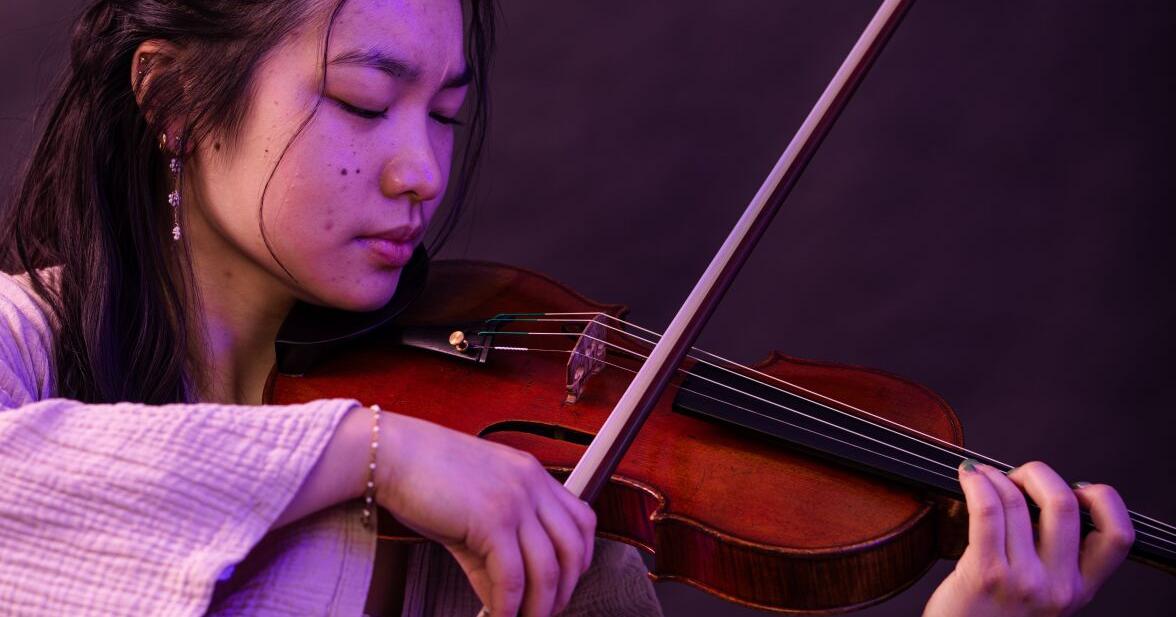Every musical instrument has a unique story, each with a distinct personality. Some, centuries old, have been passed down numerous times, from one generation of musicians to the next. Here are the weird and absurd stories behind five instruments that can be heard on stages across Toronto.
Violin | Matthew Hakkarainen
One of the largest and most important collections of musical instruments in North America comes from a source that you might not expect. It’s not a museum. Nor is it a music school. It’s actually a machine manufacturer in Drummondville, Que., that produces — among other things — gearboxes, drive axels and hot tub covers.
That the Canimex Group is such an important player in the classical music scene is thanks, in large part, to its president, Roger Dubois, who collects instruments and lends them to Canadian musicians, including violin virtuoso Kerson Leong, members of the Montreal Symphony Orchestra and Matthew Hakkarainen, the incoming associate concertmaster of the Toronto Symphony Orchestra.
The violin on loan to Hakkarainen was made by the Italian luthier Giuseppe Guadagnini in 1790. And it’s paired with a bow by the 19th-century French archetier Étienne Pajeot.
“Each violin is almost like a person with its own voice,” said Hakkarainen. “You can often tell there are certain characteristics of violins from different periods of time and from different places. Italian violins, especially old ones like this, tend to have a little more of a zingy quality to them, while French violins are more like a blank canvas.”
Cimbasso | Mark Tetreault
The TSO’s cimbasso spends most of its days locked up backstage at Roy Thomson Hall. If musician Mark Tetreault is lucky, he gets to pull it out once or maybe twice a season.
The reason there’s so little repertoire written for this brass instrument is because it was only in vogue for several decades before falling out of favour. It was developed in the 19th century. One of the first composers to call for its use was Verdi, who was looking for an instrument with a range similar to a tuba but with a sound more akin to a trombone. “Verdi wanted something that was light and bright,” explained Tetreault, whose primary instrument is the tuba. “He thought the tuba was too dark.”
The cimbasso soon became popular among Italian composers, and can be heard in operatic works such as Verdi’s “Otello” and “Falstaff.” It then experienced a renaissance of sorts in the mid-20th century thanks to Hollywood and a tubist named Tommy Johnson (Tetreault’s teacher’s teacher, or “grandteacher,” as the TSO musician refers to him), who introduced the cimbasso to film composers, who in turn fell in love with the instrument’s unique sound. The cimbasso can be heard in many popular movies and video games today.
The particular cimbasso that the TSO owns, said Tetreault, is affectionately named the “Sir Andrew Davis cimbasso.” It was acquired during the tenure of the late TSO music director, who, at the time, was set to conduct a concert of Verdi’s “Requiem” and wanted an actual cimbasso to be used instead of a tuba. A call to the instrument maker Wessex and some $4,000 later, this instrument has been with the orchestra ever since.
Violin | Tiffany Yeung
For years, this violin sat on Greg Cook’s bookshelf. He had inherited it after his maternal grandfather died. But no one in his family thought it was anything more than a knick-knack.
It wasn’t until the instrument’s neck broke and Cook brought it in for repairs that he and his family discovered that the family heirloom wasn’t just any old violin; it was one crafted by the prolific French luthier Jean-Baptiste Vuillaume at the peak of his career in 1869.
In 2009, following this discovery, Cook and his wife donated the instrument to the Canada Council for the Arts. It’s currently on a three-year loan to Tiffany Yeung, a student at the Royal Conservatory of Music who won the violin through the council’s Musical Instrument Bank competition.
The violin’s two-piece back is made of maple, while its front is crafted of spruce, finished with a reddish-brown varnish. “It’s a very warm, rich and very sweet sound,” described Yeung. “And paired with this (Vuillaume model) bow, the violin is just incredibly smooth.”
Violoncello piccolo | Keiran Campbell
Sitting at the back of a concert hall, you’d be forgiven for thinking that Keiran Campbell’s instrument is just an average cello. But take a closer look and you’ll see that it’s far from typical. The instrument is much smaller than a modern cello. Its bow curves outward instead of in. And, most notably, it has five strings instead of four.
Campbell’s particular instrument is known as a violoncello piccolo, which literally translates to “small cello.” Made by the French luthier Nicolas Augustin Chappuy sometime in the mid-18th century, it was crafted before the size of string instruments was formalized — when you could find odd-sized variants and hybridized instruments of all kinds.
The violoncello piccolo possesses a unique sound: “It’s not as rich, in the sense of having a really wide, deep sound (as the modern cello), but it’s more a sort of focused, sweet sound,” said Campbell, a luthier and member of the Tafelmusik Baroque Orchestra. The instrument’s higher range allows it to play music originally written for the violin, but one octave lower. Some musicologists suspect that some or all of Bach’s cello suites might have been written for this instrument.
Campbell’s particular cello previously belonged to his former stand partner, Allen Whear, who died in 2022. That he now gets to play it is “very special,” said Campbell. “It’s amazing how these old instruments sort of cycle through different generational of musicians and have such personalities attached to them.”
Baroque bassoon and dulcian | Dominic Teresi
Dominic Teresi’s baroque bassoon and dulcian look like they’re centuries old. The wood on each is finely aged. The bassoon, in particular, is richly ornamented in a style from a bygone era. But both instruments, in fact, were only made in the 21st century.
Rather, the pair of woodwinds are exact replicas of far older instruments. Teresi’s bassoon is a copy of one originally made in Germany in the 1720s. The instrument, crafted out of maple wood, differs from a standard modern bassoon in that it only has five keys instead of 24. Its bore, or internal chamber, is also larger than most bassoons today, lending it a more relaxed, softer sound. Meanwhile, Teresi’s dulcian, a precursor to the bassoon, is a replica of an even older instrument believed to be made in Italy in the 1600s and now displayed at a museum in Berlin.
Creating these modern-day copies is both an art and a science. Woodwind makers often start by taking exact measurements of each model instrument. But because wood gradually deforms over time, due to changes in moisture and temperature, they also make inferences on what the shape and size of the instrument would have been when it was new.
For musicians like Teresi, artistic co-director of Tafelmusik, playing early music on these instruments is special and only feels right. “We are playing the music of these times using instruments that the composers would have known and written for,” he said. “These instruments actually kind of guide you towards a particular interpretation of the music that goes with the esthetic of the time. These instruments get to the heart of that.”



